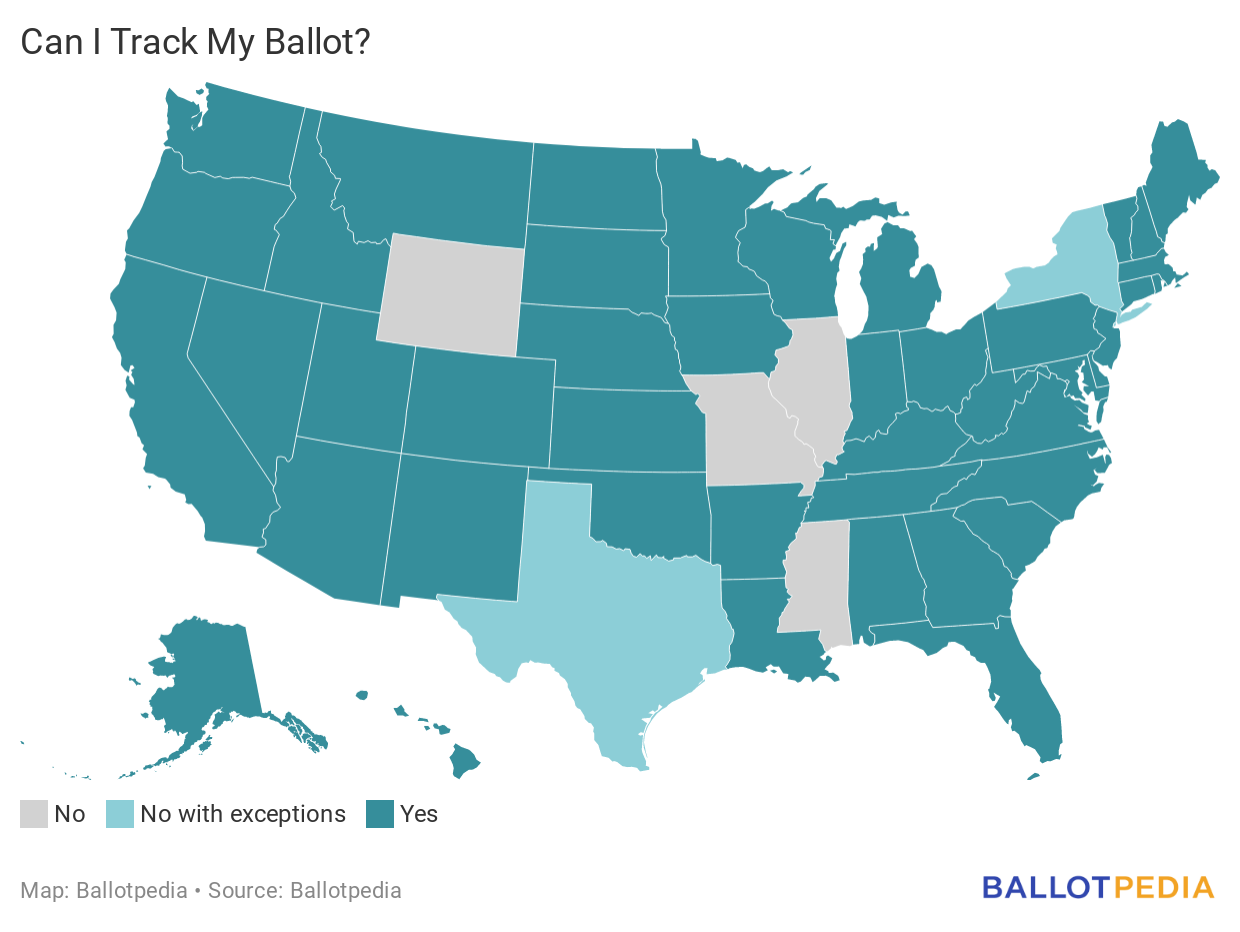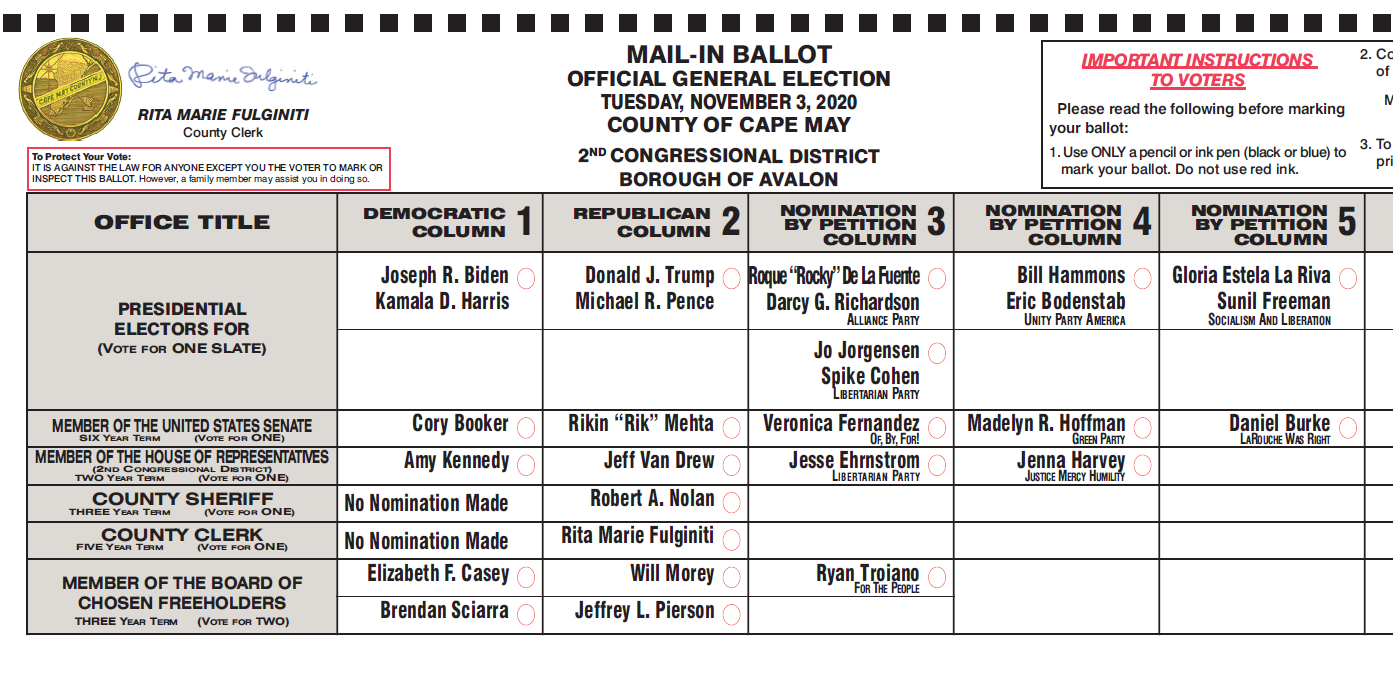Welcome to the Wednesday, October 28, Brew. Here’s what’s in store for you as you start your day:
- Can I track my ballot?
- Sample ballots from all 50 states
- Explore Alaska elections
- Explore Massachusetts elections
Can I track my ballot?
There are six days until the close of voting on Election Day—Nov. 3. If you decided to vote using an absentee or mail-in ballot, you may be wondering if there’s a way you can see where your individual ballot is in the process. Forty-four states and the District of Columbia allow voters to track the status of their absentee/mail-in ballot online.
Of the six states that do not, Texas and New York have online ballot tracking only for military and overseas voters. The remaining four states—Illinois, Mississippi, Missouri, and Wyoming—have no online ballot tracking at the state level.

Looking for more answers about how the 2020 election will be conducted, from the casting of ballots to the certification of final results? Visit our Election Help Desk pages or click here to subscribe to our Election Help Desk Newsletter.
Sample ballots from all 50 states
Are you the ultimate political enthusiast, like me? If so, this story is definitely for you. The voting process has been more heavily discussed this year than any election in quite some time. One of our favorite things to collect each year are examples of the sample ballots in each state. After all, while we all vote on the same general election date, what isn’t always clear is how different – visually – ballots are designed from state-to-state.
Here are pictures of two sample ballots—one from Mississippi and one from New Jersey:


We’ve gathered images of official 2020 sample ballots from all 50 states. These are just for illustrative purposes since ballot preparation procedures vary by state and between jurisdictions within states. Consequently, sample ballots in different jurisdictions in the same state may not be identical.
Of course, to see your official sample ballot, contact your local election agency. To learn more about what is on your ballot, try Ballotpedia’s sample ballot tool, or download our mobile app, My Vote Ballotpedia.
But to get started on a political journey looking at ballots across the country, click the link below!
Explore Alaska elections
We have just six states remaining in our 50 States in 25 Days series, and today we’re previewing Alaska and Massachusetts. These two states are about as far as you can get in the United States, with more than 3,300 miles separating them. If you missed a day, here are the states we’ve highlighted so far, along with a map summarizing where we are in the series:
Week One: Alabama, Arkansas, California, Texas, North Carolina, Mississippi, Illinois, Ohio, Nebraska, and Oregon
Week Two: Montana, New Mexico, Iowa, South Dakota, Indiana, Pennsylvania, Idaho, Maryland, Nevada, and South Carolina
Week Three: North Dakota, West Virginia, Georgia, New York, Kentucky, Virginia, Colorado, Utah, New Jersey, and Oklahoma
Week Four: Maine, Missouri, Arizona, Michigan, Kansas, Washington, Hawaii, Tennessee, Vermont, and Wisconsin
Week Five: Connecticut, Minnesota, Florida, and Wyoming

On the ballot in Alaska
At the federal level, Alaska voters will elect three presidential electors, one U.S. Senator, and one U.S. Representative. Both chambers of the state legislature are on the ballot, with 10 out of 20 seats in the state Senate and all 40 state House districts up for election. A special election is being held for one seat in the state Senate. One seat on the state supreme court and one intermediate appellate court seat are on the ballot. Voters will also decide on two statewide ballot measures. Ballotpedia is tracking local elections in Anchorage.
Partisan balance
- In 2016, Donald Trump (R) defeated Hillary Clinton (D) 51% to 37% in Alaska. Lyndon B. Johnson was the last Democrat to win the state in a presidential election in 1964.
- Both of Alaska’s U.S. Senators—Dan Sullivan and Lisa Murkowski—are Republicans.
- Republican Don Young represents Alaska’s at-large U.S. House district.
- Alaska’s governor and attorney general are both Republicans, meaning it is one of 19 states with a Republican triplex (the third triplex office, secretary of state, does not exist in Alaska). It has held this status since Governor Mike Dunleavy (R) assumed office in 2018.
- Republicans have a 13-7 majority in the state Senate and the governor is a Republican. Following the 2018 elections, 2 Independent, 15 Democratic, and 4 Republican House members split control of key leadership positions in a power-sharing agreement, meaning Alaska has divided trifecta control. Alaska has had divided control since 2015.
Ballot measures
- Alaska voters will decide two statewide measures on Nov. 3. Both are citizen initiatives.
- Ballot Measure 1 would increase taxes on certain oil production fields.
- Ballot Measure 2 would establish ranked-choice voting for general elections, including the presidential election. It would also replace partisan primaries with open top-four primaries for state executive, state legislative, and congressional offices.
Voting
- Alaska’s witness requirement for absentee/mail-in ballots has been suspended as the result of a court order.
- Voters can return their absentee/mail-in ballots in person or by mail. Ballots returned in person must be received by 8 p.m. on Nov. 3. Ballots returned by mail must be postmarked on or before Nov. 3 and received by Nov. 13. Click here to check the status of your ballot.
- In the 2018 general election, absentee/mail-in ballots represented 8.2% of all votes cast in Alaska.
- Alaska law allows election officials to begin counting absentee/mail-in ballots after polls close on Election Day.
- Alaska requires all voters to present non-photo identification at the polls. For more information about Alaska’s voter ID requirements, click here.
- Early voting began on Oct. 19 and ends on Nov. 2.
- In Alaska, polls are open from 7 a.m. to 8 p.m. on Election Day. Most of Alaska is in the Alaskan time zone. Parts of the Aleutian Islands are in the Hawaii-Aleutian time zone.
Explore Massachusetts elections
On the ballot in Massachusetts
At the federal level, Massachusetts voters will elect 11 presidential electors, one U.S. Senator, and nine U.S. Representatives. All eight seats on the governor’s council are up for election. Both chambers of the state legislature are on the ballot, with all 40 seats up in the state Senate and all 160 state House districts. Voters will also decide two statewide ballot measures. Ballotpedia is tracking local elections in Suffolk County.
Partisan balance
- In the 2016 presidential election, Hillary Clinton (D) defeated Donald Trump (R) in Massachusetts 60% to 33%. Aside from Ronald Reagan, who won Massachusetts in 1980 and 1984, no Republican presidential candidate has won Massachusetts since Dwight Eisenhower in 1956.
- Massachusetts is one of 16 states that does not have a Pivot County. Pivot Counties voted for Barack Obama (D) in 2008 and 2012, then voted for Donald Trump (R) in 2016.
- Both of Massachusetts’ U.S. Senators are Democrats.
- All nine of Massachusetts’ U.S. House members are Democrats.
- Massachusetts’ governor is a Republican, and its attorney general and secretary of state are Democrats. This makes Massachusetts one of 14 states with divided triplex control. It has held this status since 2015.
- Democrats hold a 36-4 majority in the state Senate and a 127-31 majority in the state House. Because the governor is Republican, Massachusetts is one of 14 states with divided government. It has held this status since 2015 when Charlie Baker (R) became governor.
Ballot measures
- Massachusetts voters will decide two statewide measures on Nov. 3. Both are citizen initiatives.
- Question 1 would require manufacturers that sell vehicles with telematics systems in Massachusetts to equip them with a standardized platform that vehicle owners and independent repair facilities may access to retrieve mechanical data and run diagnostics through a mobile-based application. Question 2 would enact ranked-choice voting (RCV) for primary and general elections for state executive officials, state legislators, members of Congress, and certain county offices beginning in 2022.
Voting
- In response to the Covid-19 pandemic, Gov. Charlie Baker (R) signed into law legislation extending absentee/mail-in voting eligibility in the general elections to all qualified voters.
- Massachusetts does not require witnesses or notaries to sign absentee/mail-in ballots.
- Voters can return their ballots in person or by mail. Ballots returned in person must be received by 8 p.m. on Election Day. Ballots returned by mail must be postmarked on or before Nov. 3 and received by Nov. 6. Click here to check the status of your ballot.
- In the 2018 general election, absentee/mail-in ballots represented 3.1% of all votes cast in Massachusetts.
- Massachusetts law allows election officials to begin counting absentee/mail-in ballots after polls close on Election Day.
- Massachusetts does not require all voters to present identification at the polls.
- Early voting began on Oct. 17 and ends on Oct. 30.
- In Massachusetts, polls are open from 7 a.m. to 8 p.m. on Election Day. Massachusetts is in the Eastern time zone.

